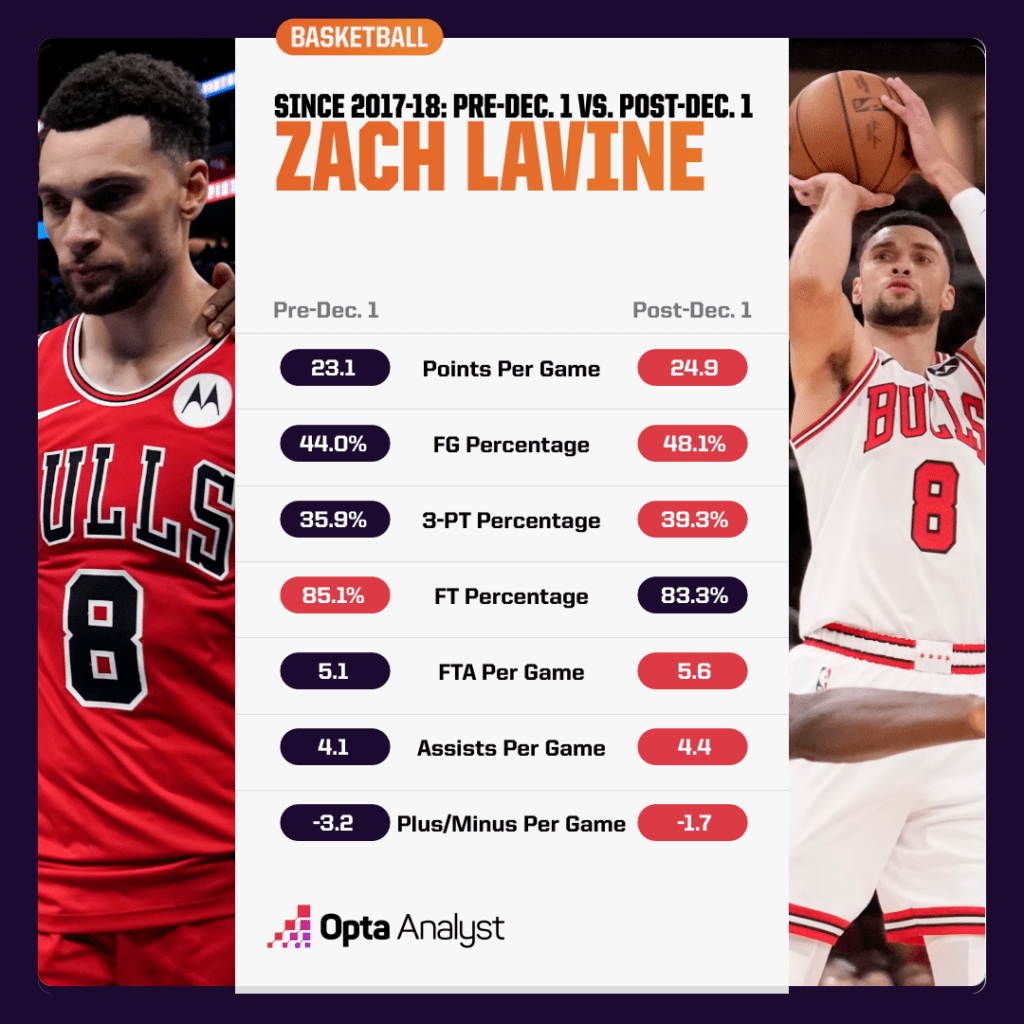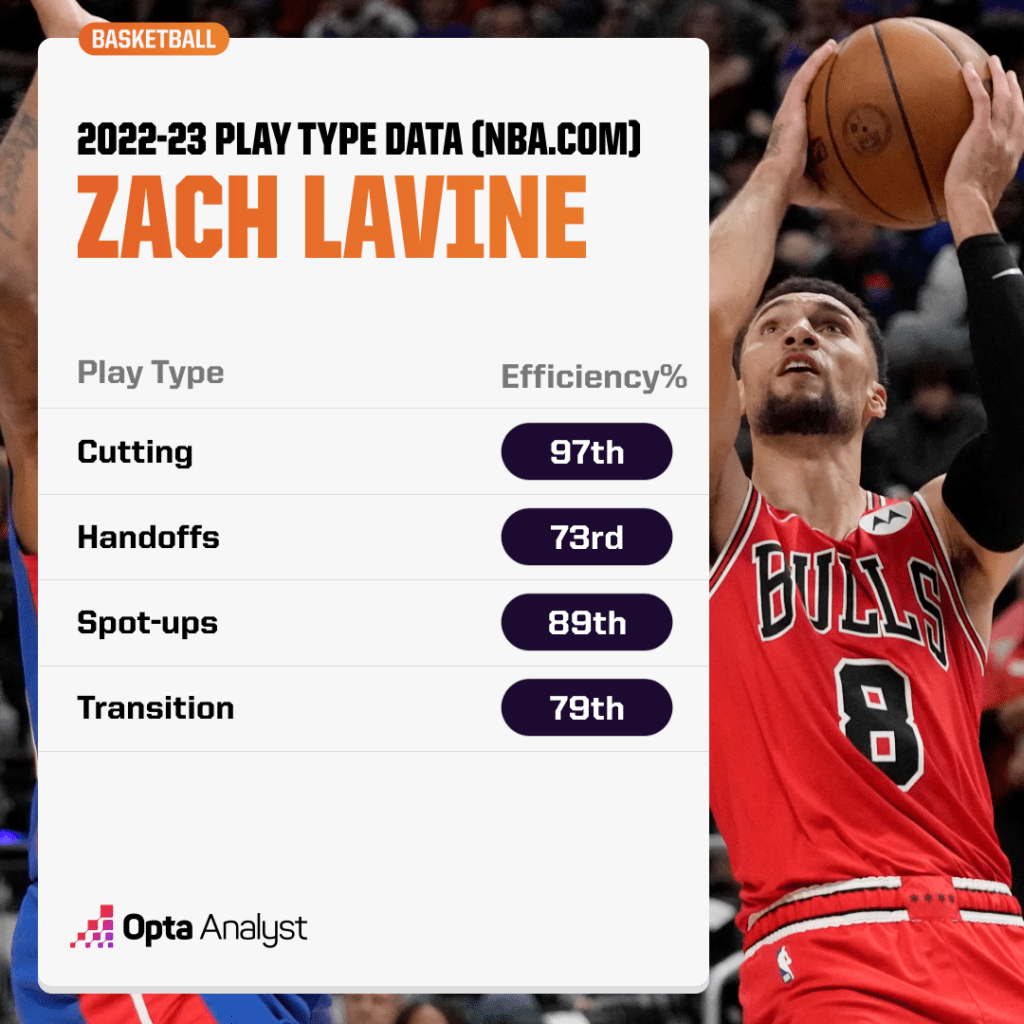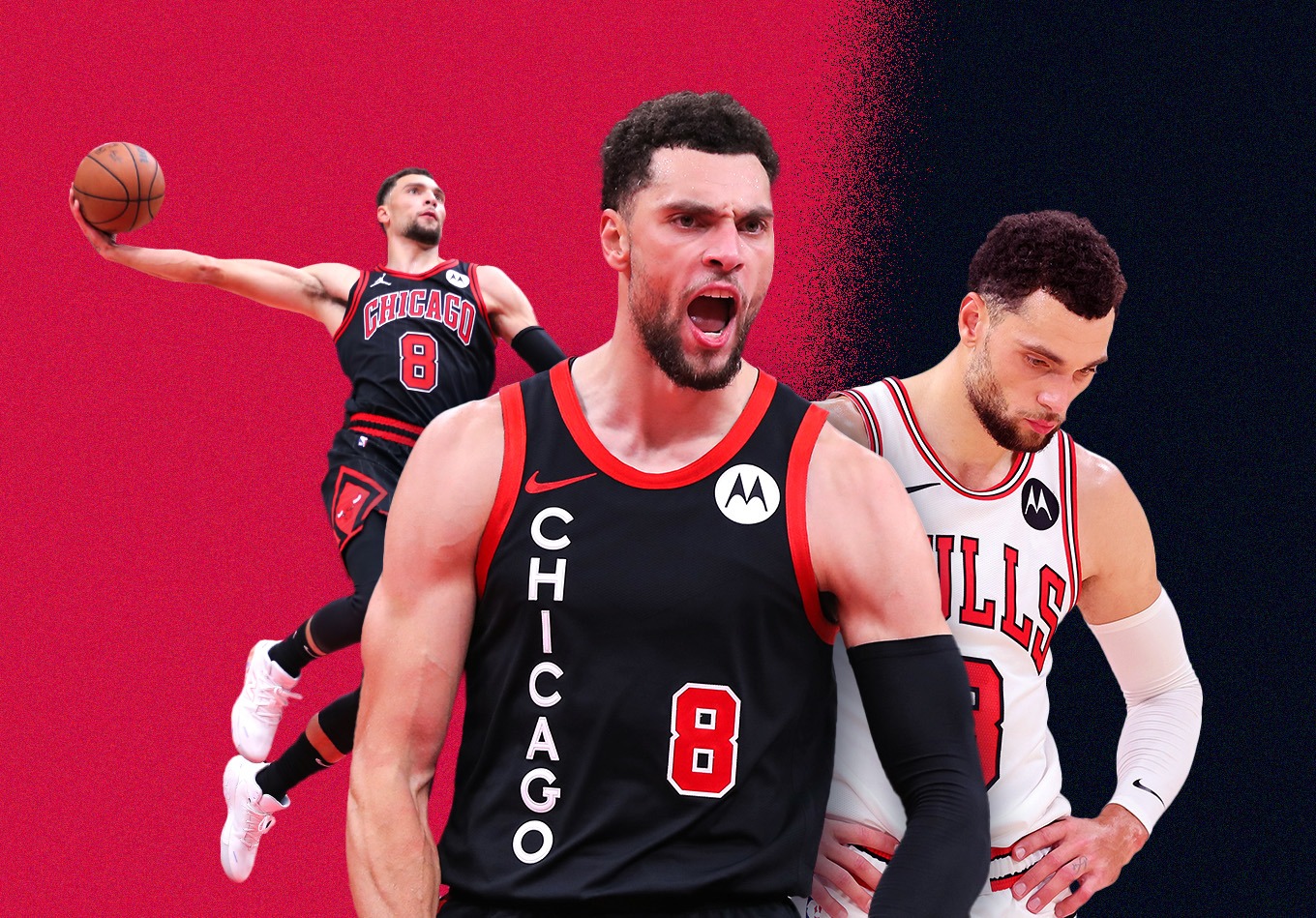Last week, it was reported by Shams Charania of The Athletic that guard Zach LaVine and the Chicago Bulls front office were willing to explore the possibility of a trade.
Now, the Bulls are on everyone’s radar (as they may be willing to move valuable pieces like DeMar DeRozan, Nikola Vucevic and/or Alex Caruso, too) and LaVine is at the center of every trade rumor.
But what makes LaVine, who is owed 178 million dollars over the next four seasons, worth trading for? What skills does he bring to the table? And which teams are properly equipped to maximize those abilities?
Let’s take a look.
What the Bulls’ Zach LaVine Brings
At a glance, LaVine’s 21.3 points per game on 56.7% true shooting (minus-0.8% below the league average) reeks of empty-calorie, low-efficiency scoring. However, LaVine has a history of slow starts (and he isn’t exactly satisfied in Chicago right now).
Last season, prior to Dec. 1, LaVine was averaging 20.9 points with a 53.1 true shooting percentage. After Dec. 1, LaVine flipped the switch and vaulted those figures up to 26.0 points on 62.7% true shooting.
And that’s been a common trend since he joined the Bulls in 2017-18.

It is always tricky trying to use early season data to interpret a player’s value, especially one with a proven body of work like LaVine. With guys like him, you need to be sure to account for past performance.
Our offensive one-number metric, offensive DRIP (O-DRIP), does just that. According to that measure, LaVine is 14th in the entire NBA with an O-DRIP of 3.5 (minimum 100 minutes played).
With that in mind, we’re going to focus on LaVine’s 2022-23 statistics when discussing what he could bring to a future employer.
Based on all the numbers we’ve spit at you so far, you can probably tell that LaVine is adept at getting buckets. But there is a lot more to it than that. LaVine can get buckets… from all three levels.
Last season, LaVine shot 63.4% at the rim (63rd percentile), 44.0% midrange (60th percentile), and 37.5% from 3-point distance (50th percentile). Those percentiles listed in parenthesis may not seem gaudy, but you need to keep in mind how high of a volume he has to handle. For instance, LaVine took 9.6 3s per 100 possessions in 2022-23, which put him in the 79th percentile league-wide.
LaVine also has access to the most sacred region of the court: the paint. Over the years, the athletic former dunk champion has learned to leverage his God-given physical tools into an abundance of paint touches, as evidenced by him taking 7.5 free-throw attempts per 100 last season (87th percentile).
Scoring at all three levels on good efficiency is hard enough, but being able to do so while also fitting into a team concept is even more impressive. The two-time All-Star guard’s scoring comes in two forms: on and off the ball.
In 2022-23, 42.9% of LaVine’s made field goals were assisted. Juxtapose this with someone like James Harden (a known ball stopper), who only had 25.3% of his made field goals come off assists.
LaVine also has great off-ball indicators, ranking in the top quadrant (or close to it) in efficiency in off-ball centric play types like cutting, handoffs, spot-ups and transition.

Along with his scoring exploits, LaVine is a passable facilitator (no pun intended). He won’t dissect defenses like a top-rated NFL quarterback. But he can make defenses pay when they send extra defenders to try and stop his scoring.
In the montage below, you will see an example of him hitting a lay-down pass (first clip in the montage), a kick-out feed (second clip), and a pocket pass (third clip). Oh, and there is also a sequence in there of him playmaking in transition (fourth clip).
On defense, LaVine is a firm negative. The defensive version of our in-house metric (defensive DRIP or D-DRIP) has LaVine in the sixth percentile as a defender among players with at least 100 minutes played in 2023-24.
However, that doesn’t disqualify a team with LaVine from having a great defense. In fact, heading into the play-in tournament last season, the Bulls were second in our adjusted defensive rating metric despite LaVine playing 35.9 minutes per game.
He’s also got a little bit of Anthony Edwards in him in that he’s able to use his outlier athleticism to produce great on-ball defensive sequences (occasionally), like this one on Detroit Pistons guard Cade Cunningham:
So, we have an insane athlete who can efficiently score on and off the ball at all three levels while also providing some playmaking. That sounds eerily similar to the player profile we put together on Tyrese Maxey of Philadelphia 76ers last week – a player that everyone is raving about right now.
The only significant difference between the two players is their salary. And guess what? Maxey is going to become expensive soon too!
Who Should Trade For LaVine?
Now that we’ve established that LaVine is a good player who brings a ton of value and is worth trading for, we need to determine what ecosystem(s) are best suited for fully harnessing his brilliance. Think about how the Denver Nuggets were able to maximize LaVine’s dunk contest rival, Aaron Gordon.
Ideally, a team trading for LaVine should have three things. First, the team should have a need for someone who can find the bottom of the net at all three levels of the court. Second, the team needs to have a solid defensive foundation (to compensate for LaVine’s shortcomings).
And third, the team should have someone who is a better playmaker than LaVine (since he isn’t strong enough in that category to be a team’s leading man).
With those parameters in mind, there are four teams that make sense for LaVine: the Pistons, Miami Heat, New York Knicks and Los Angeles Lakers.
The Pistons have a budding defensive core in Jalen Duren, Ausar Thompson and Isaiah Stewart. They are in desperate need of spacing (30th in 3-point attempts). And they have Cunningham to alleviate primary creation duties from LaVine.
Erik Spoelstra’s Heat have Jimmy Butler and Bam Adebayo to anchor their defense. None of their primary offensive engines can score at all three levels (Butler and Adebayo aren’t good outside shooters and Tyler Herro doesn’t put much pressure on the rim). And Butler has proven on numerous occasions that he can be the offensive No. 1 on a title contender.
The Knicks have gotten off to a strong defensive start this year (No. 9 in defensive rating). They need more outside shooting to improve their spacing (see the 2023 Eastern Conference semifinals). And Jalen Brunson has proven over the last year plus that he can handle being in the driver’s seat for the majority of the road trip.
Lastly, the Lakers have one of the best defensive anchors in basketball in Anthony Davis. Though LeBron James and D’Angelo Russell are both hitting 2.2 3s per game, the team’s spacing is awful (29th in 3-point attempts) and LeBron needs a three-level scorer who can take some of the offensive load off him during the regular season. But during the playoffs, James (and Austin Reaves) can take over lead ball-handling duties from LaVine.
(Sidenote: The Sixers would also be a pretty nice landing spot for LaVine. The only problem there is that Tyrese Maxey may not be a good enough on-ball creator to make up for LaVine’s limitations).
It’s fun when a player of LaVine’s caliber becomes available because you never know how much that star’s migration may change the competitive landscape of the league.
In this case, the impact may be substantial in the right situation.
Check out all our MLB offseason analysis and NBA season coverage, and our NFL picks and college football predictions. Follow us on X and Instagram for more!
